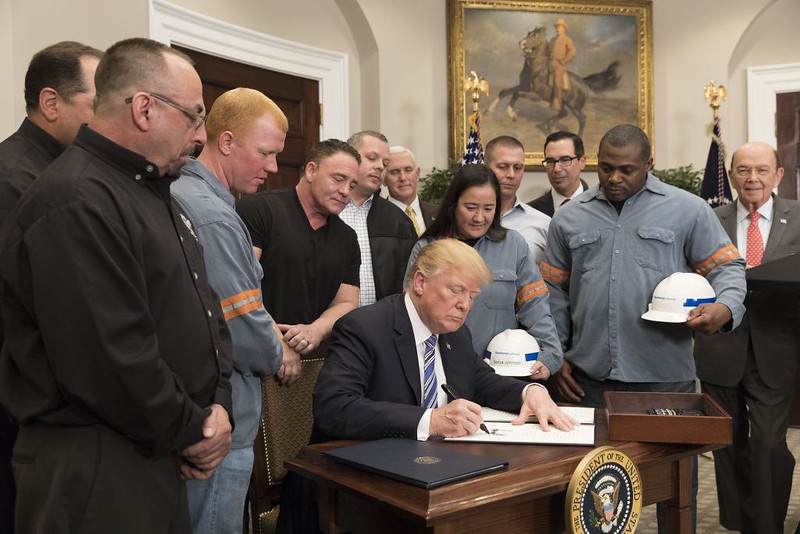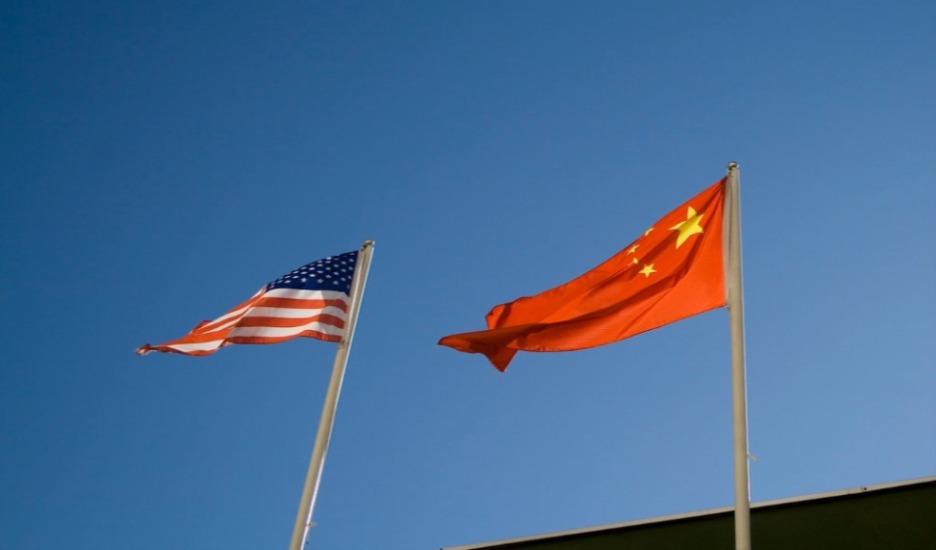Trump’s Trade Strategy Points the Way to a U.S. Carbon Tariff
As the White House’s tariffs on steel and aluminum have shown, a U.S. president has all the authority he or she needs to impose a carbon border tax.

Published by The Lawfare Institute
in Cooperation With

Over the past two decades, governments around the world have adopted mechanisms that combat climate change by putting a price on carbon emissions. Today, approximately 40 governments worldwide—including Japan, the European Union, Canada and state governments within the United States—have carbon pricing schemes of one form or another. Unfortunately, though, the globalization of manufacturing has dampened enthusiasm for tougher climate policies and slowed the spread of domestic carbon pricing mechanisms. The problem is this: If a country pushes its industries to make costly adjustments to reduce carbon emissions and the rest of the world doesn’t follow suit, its manufacturers may head offshore. After all, if Vietnam or Indonesia allow firms to pollute freely, it quickly becomes an attractive business proposition to relocate there and sell cheap products back to U.S. or European consumers.
How to resolve the tension between saving the environment and saving jobs? One possibility is a tax on carbon-intensive imports from countries that do not have stringent climate regulations. Such a tax, often called a “carbon border tax adjustment,” or sometimes a “carbon tariff” for short, raises the price of the goods taxed. By raising the price of carbon-intensive imports from countries that do not have stringent climate policies, a carbon tariff would reduce the incentive to shift production offshore. This would keep domestic industry competitive if carbon pricing was introduced, while also using the purchasing power of the domestic economy to incentivize decarbonization abroad.
After years of debate both in national capitals and at the World Trade Organization (WTO), momentum finally seems to be gathering for a carbon tariff. The European Union recently introduced a proposal for a carbon border adjustment mechanism as part of its EU Green Deal. Joe Biden, the 2020 Democratic nominee for president, has proposed a carbon adjustment fee or quota on imports that do not meet U.S. environmental standards. And Jennifer Hillman, a widely respected former WTO Appellate Body member, wrote an influential report arguing that a nondiscriminatory carbon border tax would be consistent with WTO rules—a view that is increasingly widespread.
But while the EU moves ahead with its plans to impose a carbon border adjustment, similar policies have remained elusive in the United States. Even if Joe Biden wins the White House, an increasingly polarized Congress might struggle to pass legislation that would authorize a carbon tariff—particularly if Democrats do not win supermajorities in November. Absent new legislation, presidential administrations still have a lot of delegated authority in the form of general statutes like the Clean Air Act on which they can fall back. Indeed, this domestic regulatory authority is how President Obama intended to implement the commitments his administration made in the 2015 Paris Agreement. But major policies implemented by the executive branch alone must still go through often slow administrative processes, like those required by the Administrative Procedure Act, that are designed to inject deliberation and public input into executive branch policymaking. On the other side of those administrative processes, inevitable court challenges can tie up an administration’s policies for months or years.
For a carbon tariff, though, a U.S. president has a far easier path forward. A Cold War-era law, known as Section 232 of the Trade Expansion Act of 1962, gives the president the authority to “adjust the imports” of any product that “threatens to impair the national security” of the United States. While the phrase “national security” makes most people think of defense and foreign affairs, Congress made clear that it wanted the president to take a much broader view. In assessing threats, Congress directed the president to “recognize the close relation of the economic welfare of the Nation to our national security” and to consider “the impact of foreign competition on the economic welfare of individual domestic industries; and any substantial unemployment, decrease in revenues of government, loss of skills or investment, or other serious effects resulting from the displacement of any domestic products by excessive imports,” as well as any other factors the president deems relevant. The president can then act on his or her assessment without further authorization by Congress.
Put simply, Section 232 links national security to economic security and, in doing so, gives the president carte blanche to regulate imports that he or she decides affect some aspect of the nation’s economic well-being. Section 232 also gives the president his or her choice of policy instrument—the president can impose tariffs, fees or quotas. Congress even gave advance consent to international agreements that adjust imports. Taking Congress up on its broad invitation, President Trump has used Section 232 to impose tariffs on steel and aluminum imports, and he has threatened to impose tariffs on auto imports as well. Past presidents have used these powers to “adjust the imports” of oil and for other purposes.
Section 232 thus provides a U.S. president with all the authority he or she needs to impose a carbon tariff.
This is not as far-fetched as it sounds. Over the past three years, both the courts and Congress have considered the scope of presidential authority under Section 232. Given the breadth of the definition of national security, courts have been unable to find limits in the substantive grant of authority. In June 2018, the American Institute of International Steel and two of its members filed a suit in the U.S. Court of International Trade, charging that Section 232 violates the nondelegation doctrine, a constitutional rule that prohibits Congress from wholesale transferring its constitutional authorities to the executive branch. In this case, the plaintiffs argued that Congress had impermissibly transferred its exclusive constitutional authority to impose taxes and regulate foreign commerce. (In full disclosure, one of us—Meyer—represented the plaintiffs in that case.) But, relying on a 1976 Supreme Court decision, the lower courts turned the challenge away and in June of this year the Supreme Court declined to hear the case, effectively blessing presidential discretion to regulate imports based on an expansive conception of security.
Section 232 has virtually no administrative guardrails, so substantive challenges to the president’s exercise of discretion under Section 232 are almost impossible. The Supreme Court long ago held that the president is not an “agency” and that his or her decision-making processes are thus not subject to the Administrative Procedure Act. Nor does Section 232 itself provide any explicit basis for review of presidential decisions. To be sure, the statute does require an investigation by the Commerce Department, which must first determine that imports threaten to impair the national security before the president can act. That investigation and the president’s decision-making process must also adhere to certain timelines, the violation of which does provide a basis for challenging Section 232 measures. But the time limits are hardly burdensome and the Commerce Department is not an independent agency. It works for the president, and its deliberations might properly be influenced by the administration’s policy goals.
Congressional efforts to reform Section 232 have gotten little more traction. A number of bills have been introduced, but none has made it out of committee. Congress has had good reason to revisit the scope of the president’s authority, since the Trump administration’s use of Section 232 has led to job losses in the United States and has disrupted relationships with staunch U.S. allies like Canada and the EU. But, absent veto-proof majorities in both houses of Congress, amending Section 232 would require the president’s consent—and it is hard to see why an incoming administration would give up the kind of authority that Section 232 confers. Any reform of Section 232 under a future Biden administration would therefore likely have to grandfather in that administration’s policies, as some of the proposed reforms would have done for the Trump steel and aluminum tariffs. A future reform-minded administration might even insist on a “sunrise” clause, which would delay any amendment’s effectiveness until after the next presidential election.
Section 232 is therefore likely here to stay, at least for the medium term, and carbon tariffs would be a much more defensible use of the broad 232 authorities than Trump’s erratic approach. The Defense Department has already concluded that climate change poses a threat to national security, even as conventionally understood. And significant research suggests that decarbonizing the economy need not slow economic growth and is even likely to support greater economic productivity. Moreover, Section 232’s ex ante grant of authority to conclude international agreements allows the president to work with U.S. allies on carbon tariffs, rather than antagonizing them through unilateral action. Indeed, having on hand a Commerce Department report that recommends security-motivated restrictions on carbon-intensive imports (even if the president does not ultimately impose the restrictions) can motivate allies and competitors alike to come to the table.
Previous administrations have resisted aggressive use of economic national security authorities to advance policy objectives not obviously connected to core notions of national security. But the Trump administration has opened that box. It may be the ultimate irony of our era that a president who makes trade policy by tweet showed his political adversaries how to achieve their own policy goals.



.jpg?sfvrsn=5a43131e_9)


